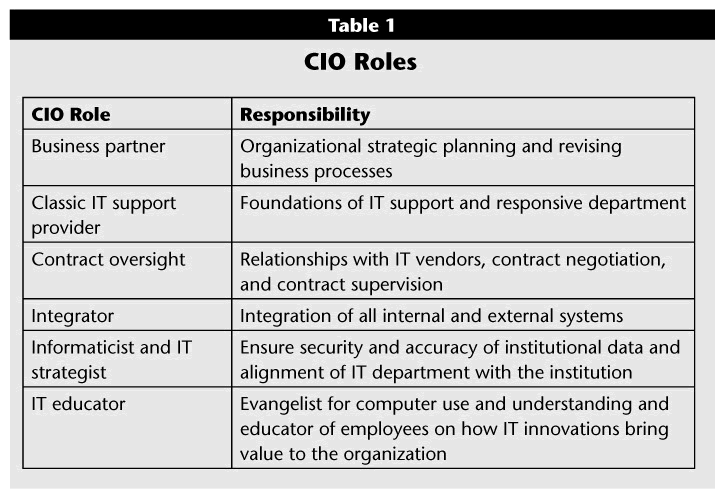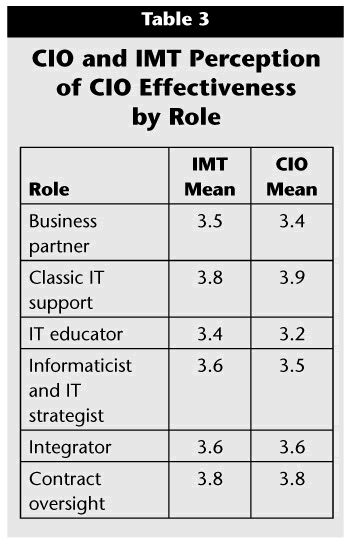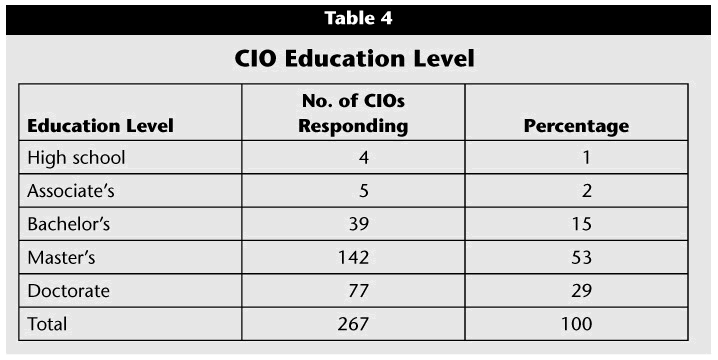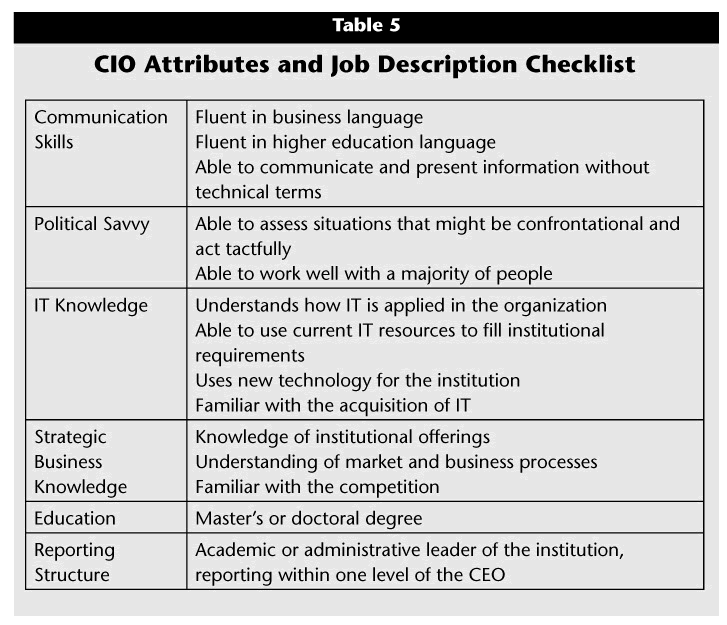Information technology departments, and therefore chief information officers (CIOs), can have a communication and action gap with their institutions and leadership.1 This gap and its resulting difficulties are well documented in IT leadership literature. Like a domino effect, the gap not only causes inefficiency among departments using technology services, it also erodes interdepartmental relationships, thus compounding the gap’s negative effects.2
IT has gotten a bad rap, and some of it may be deserved. The industry, in spite of a surge in personal and commercial technology ranging from home e-mail to complex financial infrastructures, has been the subject of widespread negativity. The criticism has even found its way into comedy skits on the television program Saturday Night Live in the form of character Nick Burns. Burns is a company technology employee who has forgotten or never learned that his job is to support the organization’s mission. The character is arrogant, demeans other employees for their lack of IT knowledge, and seems unresponsive and indifferent to their needs. The real jab at the IT industry comes because Burns, as a type, is not completely fictional. While the character might not represent the majority of technologists, almost everyone has met a Nick Burns. Employing this sort of staff person might signify a rift between the IT department and the rest of the institution. While the satirical character on the comedy program is meant to entice laughter, the caricature has roots in a reality that can impair an institution’s ability to function.3
From an end user’s perspective, the Nick Burns character is alive and well in IT organizations.4 Often the IT employee is not trusted, and the end user of technology as well as the institutional leadership may view the employee negatively.5 This lack of confidence in the IT group can lead to a further degradation of service, and the IT group might become defensive.
Background
The gap between IT and the institution poses a major challenge if the senior IT executive, or the CIO, does not have the necessary skills and ability to lead a rapidly evolving IT department. IT’s potential impact has made it critical to the operation of the institution. As a result of IT’s organizational importance, the CIO position has evolved from a technical person holding a managerial role to an education and business executive assuming the technical post.6 The nature of the position makes the CIO responsible for successfully bridging any communication and action gap between the organization and IT.
In 1990, Penrod, Dolence, and Douglas examined the role of the approximately 200 CIOs in higher education as well as the expectations of the position.7 A decade later, the number of CIOs in higher education had grown to more than 1,300.8 What’s more, their position had evolved with the rapidly changing technology environment as well as with changing campus demands.
The majority of administrative functions within higher education institutions run on some type of information system. E-mail and Web pages are major communication tools. Furthermore, institutions may become so reliant on technology systems that an IT failure negatively affects their primary business. The person who can address communication and action problems is the CIO.
IT leaders may have become successful as technologists during a time when technology was centrally located in a server room and the only interface other employees had with technology was through a terminal. Becoming successful in that centralized configuration, where the technology was new to everyone and only supported a few organizations within an institution, required a certain set of skills.9 As the CIO moved to a more strategic role in the institution, the attributes needed to be effective have changed. The IT department and leader may encounter difficulty in changing their approach and style as the environment changes, however.
The CIO Study
In 2004, I conducted a nationwide study to create a detailed description of an effective and successful CIO within a higher education environment. The results provide insight into effective IT leadership by examining CIO attributes, membership on the management team, an organization’s strategic view of IT, and the impact a centralized or decentralized IT organization has on a CIO’s effectiveness. My research highlighted the circumstances under which IT leaders, and consequently the IT department and institution, have the best chance of success.
The study group consisted of CIOs working in four-year higher education institutions in the United States with accreditation recognized by the U.S. Department of Education (USDOE). A list of all relevant institutions and their addresses was electronically extracted from the USDOE Integrated Postsecondary Education Data System (IPEDS) peer comparison system (http://nces.ed.gov/ipedspas). In addition, the information on school president, school address, city, state, and ZIP code was extracted to facilitate survey mailings. The study consisted of 2,549 institutions.
The study scope was limited to keep the project a manageable size. The group was not divided into smaller and more homogenous sets, for example. For instance, differences between public and private institutions or those without research missions were not considered. Note that any one of these possible differences, unaccounted for, might be a limitation in applying the results to a specific part of the group or to a wider and more diverse population of higher education institutions.
My higher education CIO effectiveness study was based on CIO and management team research in the health care industry conducted by Detley Smaltz in 1999.10 Smaltz examined CIO capability, management team membership, and the organization’s view of technology leader effectiveness. The research questionnaires developed relied on items used in previous research instruments.
My CIO effectiveness study examined variables from the perspective of the CIO, reported through a survey. The survey asked about the CIO’s place in the organization’s hierarchy and the extent to which technology was deployed throughout the organization. The survey also listed 25 expectations an organization might have of a CIO and asked the CIO respondents to rank the importance of the items and rate themselves on how well they performed on each item. Rounding out the research, the study reviewed those same variables and other CIO effectiveness variables through the eyes of the other executives, the institutional management team (IMT), who reported on a 39-question survey about their organizations.
The IMT survey addressed CIO attributes, targeting business knowledge of the organization’s products and services, processes, and competition; strategic IT knowledge; political savvy; and communication. As in the Smaltz research, strategic business knowledge included the CIO’s knowledge of institutional products and services; market and business processes; and competition. Strategic IT knowledge was accounted for by the CIO’s understanding of how IT is applied in the organization, ability to use current IT assets to fill needs, application of new technology for the institution, and acquisition of IT. Political savvy was measured by the CIO’s ability to assess and act tactfully in situations that may be confrontational and by the ability to work well with a majority of people. Furthermore, the CIO must be able to communicate effectively.
My study measured management team membership through four variables. The first variable was the CIO’s position in the organizational hierarchy, specifically whether the CIO was an IMT member. The extent of the CIO’s formal and informal networking activities were also factors. The extent of a trusting relationship with IMT members was the last variable examined.
The survey also evaluated IT strategic vision by measuring IT usage in the organization and what the technology accomplished for that organization. Smaltz used Schein’s concept of the strategic vision of IT11 as an independent variable—the organizational view of IT—to test the impact on the dependent variable, CIO effectiveness. My research also examined assessment of the IT department’s degree of centralization.
My higher education study analyzed the CIO’s roles as business partner, provider of classic IT support, overseer of IT contracts, integrator, informaticist and IT strategist, and IT educator. Table 1 summarizes the roles and the actions expected of the CIO in those roles.

Replicating Smaltz’s research model as a quantitative and qualitative case study, my higher education CIO study reviewed the CIO role in education today. Of the more than 2,500 CIOs invited to participate in the research, 267 CIOs responded. All IMT members from those institutions were contacted with IMT surveys, and 149 management team members from 117 institutions responded. Table 2 shows the number of responses from the CIO and IMT institutions compared to the percentage of the entire population for that institution type.
The IMT survey responses were analyzed and perceived CIO effectiveness was assessed for each CIO role. The CIO’s reporting level, membership on the IMT, interaction with the IMT, and institutional view of IT were then reviewed to determine if these variables had an impact on CIO effectiveness. This two-step approach provided a perspective from the management team to help mitigate a bias which may appear in surveys completed only by CIOs.12 The information collected was aligned with characteristics of an effective CIO or those that might affect a CIO’s effectiveness: CIO attributes, management team membership and interaction, an organization’s view of IT, and the centralization or decentralization of an organization’s IT department. The survey questions supported the collection of data about these areas from each CIO and members of that CIO’s management team. Statistical analysis made it possible to draw conclusions about the variables that could affect these leaders’ effectiveness.
Findings
The findings offer a list of characteristics or attributes associated with effective CIOs and shed light on several other CIO and IT department questions debated in the literature. The mean of the CIO effectiveness rating for the six CIO roles given by the IMT members consistently fell between 3.0 and 4.0—satisfactory and excellent, respectively. The highest rating mean was for the contract oversight role, followed closely by the classic IT support role. Both roles involve fundamental duties of the IT department. The department must provide service and effectively supervise potentially expensive contracts and vendors.
The two lowest CIO effectiveness rating means from the IMT survey were for the IT educator and the business partner roles. These effectiveness rating means could indicate that the IMT members perceived the CIO as not operating as effectively in delivering IT education to the institution or as a member of the organization’s strategic planning team. Overall, there was no statistically significant difference in the effectiveness ratings given by the IMT members and CIOs except in the educator role, where CIOs rated themselves lower than IMT members rated them. The results are reflected in Table 3.

Presumably, CIO attributes are positively related to effectiveness, based on the assumption that a CIO possesses basic attributes to be considered effective, much as a carpenter needs a basic set of tools. The literature was inconclusive on the topic.
My research found a correlation between the CIO’s strategic business knowledge, IT knowledge, interpersonal skills, and political savvy and CIO effectiveness as perceived by the IMT in all six CIO roles, indicating that these factors all have an impact on CIO effectiveness. Note that Smaltz found the four attributes had an impact on health care CIO effectiveness in all six roles.
In my research, IMT membership as a bivariate consisting of management team membership and interaction did not have a statistically significant effect on a CIO’s effectiveness as perceived by the IMT. More than 59 percent of the 267 CIO respondents in this research reported they were IMT members. The IMT respondents also indicated that the CIO was an IMT member in 59 percent of their 117 institutions. Despite not being a member of the IMT, the CIO could still be effective with the necessary CIO attributes or if the organizational view of IT provided an environment supportive of the IT organization.13 This finding is consistent with Smaltz, who also found that CIO membership on the management team did not affect health care CIO effectiveness.
While IMT membership did not affect CIO effectiveness, there are other reasons to have the CIO as an IMT member. In addition to regular interaction with other executives, the CIO could gain direct insight into the challenges facing the organization that could be solved with the correct application of technology.14 Furthermore, the CIO could educate the IMT on IT capabilities and limitations. Finally, as a management team member, the CIO would be a part of the organization’s strategic planning and could lend early IT expertise to the institution’s strategy process.15 This technical insight into institutional strategy could have a positive impact on strategic planning both for the organization and for the IT department.16
The independent variable—the organizational view of IT—had no effect on the dependent variable, CIO effectiveness, in any of the six CIO roles. Smaltz also found the organizational view of IT had no impact on health care CIO attributes and effectiveness. Furthermore, the independent variable, IT centralization, had no effect on CIO effectiveness in any of the CIO roles, with the exception of the CIO business partner role. Operating in the business partner role might be easier and therefore more effective when the IT department is centralized. Smaltz did not review this aspect of IT organization and the impact it had on CIO effectiveness.
Other Findings
The literature included a number of other inconclusive or contradictory answers to questions about CIOs. For instance, industry literature has been inconclusive about whether CIOs spend less time in their current positions than their functional area counterparts. Viswadoss17 reported the average CIO’s length of employment at an organization ranged from 18 to 36 months. On the other hand, Latimer reported that in 2000 the typical higher education CIO had been in the position for four and a half years.18
My 2004 higher education CIO study found that the participating CIOs had been in their current positions for an average of five years and five months; the IMT members reported having been in their positions an average of five years and four months. Examining responses solely for CIOs from the 117 responding IMT institutions, the mean tenure for CIOs was five years and three months, indicating no statistically significant difference in the amount of time the IMT and CIO respondents had spent in their current positions. This finding casts doubt on the presumption that typical CIOs stay in their positions less time than their functional counterparts.
An overwhelming majority of the responding CIOs (82 percent) worked predominantly in higher education, and 73 percent had worked in IT for most of their careers. The majority of the CIOs, 82 percent, held a graduate degree or higher: 53 percent had a master’s degree and 29 percent a doctorate. Education results for the CIOs appear in Table 4.

Another variable debated is whether reporting to the CEO has an impact on the CIO’s effectiveness. Smaltz reported that the CIO reporting structure was not as important as whether or not the CIO interacted well with members of the IMT. Results of my research support the belief that reporting to the CEO does not have a positive effect on CIO effectiveness. In fact, when a CIO reporting to the CEO acted in the classic IT support, IT educator, or informaticist/IT strategist role, there was a negative correlation with IMT perception of CIO effectiveness. It is not immediately obvious why this negative correlation occurs.
An organizational debate about whether an IT organization should be centralized or decentralized has raged for several decades. Rocheleau reported that centralized higher education IT departments produced better results than organizations where academic computing reported to someone other than the CIO.19 According to the 149 responding IMT members in my study, 95 percent of the 117 institutions’ IT departments were centralized. The 267 CIO respondents gave a similar answer for their institutions: 89 percent of the IT departments were centralized. This result may indicate that the pendulum has swung back to centralized IT departments, consistent with the need for efficiency and security in the face of a challenging economy and an increasing number of network security and computer virus threats.20
Conclusions
My study results paint a picture of the attributes a CIO should possess and the conditions under which the CIO should operate in higher education to be viewed as effective by the members of the management team. A CIO attributes and job description checklist appears in Table 5, which could be used in the hiring, training, or professional development of IT executives.

While exploring the type and complexity of the variables affecting the CIO’s effectiveness in four-year higher education institutions in the United States, my study examined some of the common anecdotal conclusions about the variables and circumstances that have an impact on CIO effectiveness. The study also highlighted the enormity of the job before the IT leader—the number and complexity of the issues that the CIO deals with on a regular basis are substantial.
As IMTs and leadership of higher education institutions struggle with finding an effective IT leader and structure to help the organization maximize its gains from an expensive and strategic IT department, having a list of attributes and understanding the circumstances that impact CIO effectiveness may provide a way to predict the success of their current or potential IT leader. Identifying CIO strengths and organizational environments conducive to a successful IT department can help higher education institutions ensure that their mission-critical IT departments and their leaders have the best chance at successfully supporting the organization.

